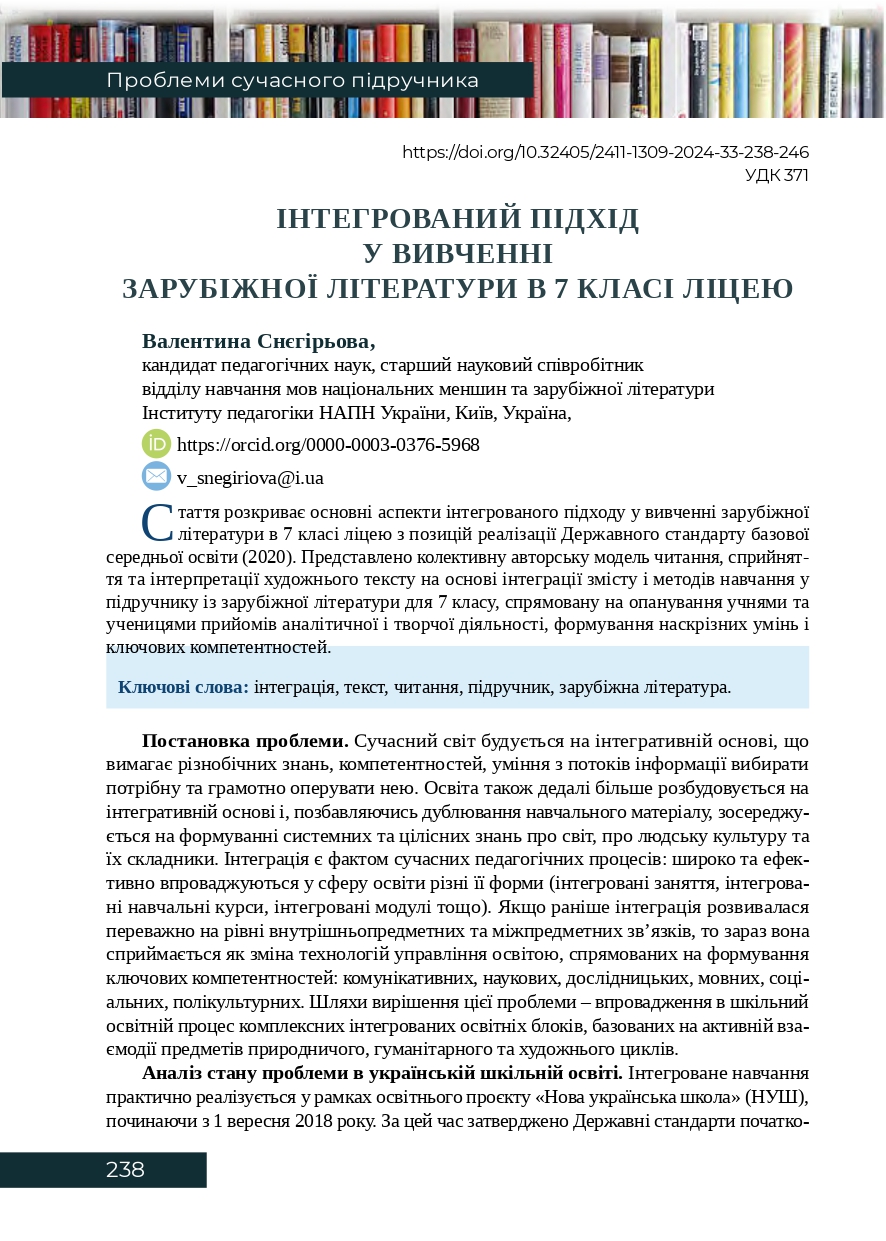INTEGRATED APPROACH IN THE STUDY OF FOREIGN LITERATURE IN THE GRADE 7 OF THE LYCEUM

Published 2024-12-31
Keywords
- integration,
- text,
- reading,
- textbook,
- foreign literature
How to Cite
Copyright (c) 2024 Валентина Снєгірьова

This work is licensed under a Creative Commons Attribution-NonCommercial-ShareAlike 4.0 International License.
Abstract
The article reveals the main aspects of the integrated approach in the study of foreign literature in the 7th grade of the lyceum from the standpoint of the implementation of the State Standard for Basic Secondary Education (2020). A collective authorship model of reading, perception and interpretation of the literary text, based on the integration of content and teaching methods, is presented. It aims to help students master the techniques of analytical and creative activity, while developing cross-curricular skills and key competencies.
In the conditions of the modern subject-based education system, which provides a didactically purposeful selection and processing of scientific facts, as well as the rapid development of integration processes across various spheres of activity, a well-thought-out, coordinated use of interdisciplinary connections and integration in education is essential.
Integration in the textbook involves a special approach to structuring and presenting the content, achieved through clear educational strategies, a system of tasks, and a focus on creating a comfortable educational environment. At the same time, it is important not only to attract information from various fields of knowledge, but also to form a methodical component of the educational process, combining the conceptual ideas of modern educational documents. Content of the subject "Foreign literature. Grades 7– 9” according to the model program (Sniehirova et al., 2023) is integrated and structured by thematic-genre (7th grade), a combination of historical-chronological and problem-thematic principles (8th – 9th grade). This creates new conditions for the activities of participants in the educational process, providing opportunities for its optimization, stimulating students' thinking, avoiding repetition of educational information, and helping students' master universal educational actions.
The artistic text is considered in the textbook as a cultural artifact containing information from various fields of knowledge, such as history, geography, biology, astronomy, mathematics, etc. Extensive study of this background knowledge contributes to a deeper integration of the cognitive and value content of artistic texts. Such work is important at all stages of the educational process.
The active aspect of integration is implemented in the textbook by combining the tasks of analyzing the literary text (for emotional perception, immersion, reflection on the text read or listened to) with communicative tasks (analysis and modeling of communication situations, role-playing reading, etc.), linguistic tasks (elaboration of elements of the original and translation), interdisciplinary tasks (for the formation of key competencies), games, etc.
Downloads
References
- Горобченко, І. В., Снєгірьова, В. В., Каєнко, О.В., Бушакова, О. В. (2024). Зарубіжна література. 7 клас. Київ: Освіта. https://lib.iitta.gov.ua/id/eprint/740473
- Державний стандарт початкової освіти. (2018). Постанова Кабінету Міністрів України від 21 лютого 2018 р. № 87. https://zakon.rada.gov.ua/laws/show/87-2018-%D0%BF#Text
- Державний стандарт базової середньої освіти. (2020). Постанова Кабінету Міністрів України від 30 вересня 2020 р. № 898. https://www.kmu.gov.ua/npas/pro-deyaki-pitannyaderzhavnih-standartiv-povnoyi-zagalnoyi-serednoyi-osviti-i300920–898
- Луценко, І. О. (2012). Забезпечення міжпредметних зв’язків та інтеграції змісту навчання у професійній підготовці майбутнього вихователя. Науковий вісник Миколаївського державного університету імені В. О. Сухомлинського: Збірник наукових праць, 1, 254–257.
- Модельні навчальні програми для 7–9 класів Нової української школи. (2022). Мовно-літературна галузь. Зарубіжна література. https://mon.gov.ua/osvita-2/zagalna-serednya-osvita/osvitni-programi/modelni-navchalni-programi-dlya-5-9-klasiv-novoi-ukrainskoi-shkoli
- Снєгірьова, В. В., Бушакова, О. В., Горобченко, І. В., Каєнко, О. В., (2023). Модельна програма «Зарубіжна література. 7–9 класи». https://lib.iitta.gov.ua/id/eprint/735726
- Типова освітня програма. (2021). https://mon.gov.ua/ua/npa/pro-zatverdzhennya-tipovoyiosvitnoyi-programi-dlya 5–9-klasiv-zagalnoyi-serednoyi-osviti
- Derzhavnyi standart bazovoi serednoi osvity. (2020). Postanova Kabinetu Ministriv Ukrainy vid 30 veresnia 2020 r. № 898. https://www.kmu.gov.ua/npas/pro-deyaki-pitannyaderzhavnih-standartiv-povnoyi-zagalnoyi-serednoyi-osviti-i300920–898 (in Ukrainian).
- Derzhavnyi standart pochatkovoi osvity. (2018). Postanova Kabinetu Ministriv Ukrainy vid 21 liutoho 2018 r. № 87. https://zakon.rada.gov.ua/laws/show/87-2018-%D0%BF#Text (in Ukrainian).
- Horobchenko, I. V., Sniehirova, V. V., Kaienko, O.V., Bushakova, O. V. (2024). Zarubizhna literatura. 7 klas. Kyiv: Osvita. https://lib.iitta.gov.ua/id/eprint/740473 (in Ukrainian).
- Lutsenko, I. O. (2012). Zabezpechennia mizhpredmetnykh zviazkiv ta intehratsii zmistu navchannia u profesiinii pidhotovtsi maibutnoho vykhovatelia. Naukovyi visnyk Mykolaivskoho derzhavnoho universytetu imeni V. O. Sukhomlynskoho: Zbirnyk naukovykh prats, 1, 254–257. (in Ukrainian).
- Modelni navchalni prohramy dlia 7–9 klasiv Novoi ukrainskoi shkoly. (2022). Movno-literaturna haluz. Zarubizhna literatura. https://mon.gov.ua/osvita-2/zagalna-serednya-osvita/osvitni-programi/modelni-navchalni-programi-dlya-5-9-klasiv-novoi-ukrainskoi-shkoli (in Ukrainian).
- Sniehirova, V. V., Bushakova, O. V., Horobchenko, I. V., Kaienko, O. V. (2023). Modelna prohrama «Zarubizhna literatura. 7–9 klasy». https://lib.iitta.gov.ua/id/eprint/735726 (in Ukrainian).
- Typova osvitnia prohrama. (2021). https://mon.gov.ua/ua/npa/pro-zatverdzhennya-tipovoyiosvitnoyi-programi-dlya 5–9-klasiv-zagalnoyi-serednoyi-osviti (in Ukrainian).
